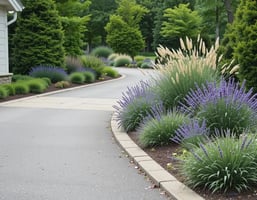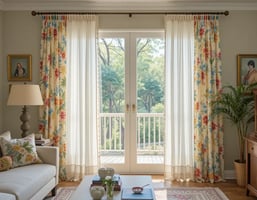Your front porch is the first thing guests see when they visit your home. It sets the tone for...
Transform Your Space: 20 Game-Changing Indoor Plant Styling Ideas That Actually Work
You know that feeling when you walk into someone's home and immediately think, "Wow, this place has serious style"? Nine times out of ten, plants are doing the heavy lifting. I've been obsessing over indoor plant styling for years now, and let me tell you – it's not just about plopping a fiddle leaf fig in the corner and calling it a day.
Disclosure: This post contains affiliate links which means I may receive a small commission at no extra cost to you!
After countless experiments (and yes, some spectacular plant murders along the way), I've discovered that styling indoor plants is an art form that can completely transform your living space. Whether you're working with a tiny studio apartment or a sprawling house, these 20 ideas will help you create that effortlessly chic, Instagram-worthy vibe we're all secretly chasing.
20. Create Drama with Ceiling-Hung Planters

Let's start strong with something that'll make your guests do a double-take. Hanging plants from your ceiling creates instant visual interest and frees up precious floor space. I discovered this trick when my coffee table became a jungle of small pots – not cute.
Choose trailing plants like pothos or string of hearts for maximum impact. The key is varying the heights – don't just hang everything at the same level unless you want your room to look like a plant prison. Position them near windows but not directly in harsh sunlight to avoid crispy leaves.
Install ceiling hooks that can handle the weight when your plants get watered. Trust me on this one – nothing kills the vibe like a soggy mess on your hardwood floors. Consider macrame hangers for that boho touch, or sleek metal ones for modern spaces.
19. Master the Art of Plant Layering

Think of your plants like a choir – you need different heights to create harmony. I learned this the hard way when all my plants were the same height and my living room looked flatter than week-old soda.
Use plant stands, books, or decorative boxes to create levels. Place taller plants in the back, medium ones in the middle, and trailing or compact varieties in front. This creates depth and makes even a small collection look intentional and lush.
Don't forget about texture mixing – pair broad-leafed plants with spiky ones, or smooth succulents with fuzzy varieties. Your eye will thank you for the visual feast, and your space will instantly feel more sophisticated.
18. Turn Corners into Green Sanctuaries

Dead corners are the black holes of interior design, but plants can transform them into focal points. I had this awkward corner in my bedroom that collected dust and random items – now it's my favorite meditation spot.
Large floor plants like monstera or bird of paradise work magic in corners. Add a small side table with a few smaller plants, and suddenly you've got a living sculpture. The trick is making it look effortless, not like you're running a plant nursery.
Consider adding a small grow light if your corner is particularly dark. Your plants will thrive, and you'll create a cozy reading nook that's actually Instagram-worthy.
17. Create Living Walls with Shelving Units

Who needs expensive living wall installations when you have creativity and some basic shelving? I turned my boring bookshelf into a green oasis, and it's become the most photographed spot in my apartment.
Mix plants with books, decorative objects, and personal items for a curated look that doesn't scream "plant hoarder." Use trailing plants on higher shelves to create natural curtains, and place upright plants at different shelf levels.
Ensure your shelving gets adequate light, or invest in some discreet grow lights. The goal is lush and lived-in, not struggling and sad.
16. Group Plants by Threes (The Magic Number)

Ever heard of the rule of threes? It applies to plant styling too, and it's basically foolproof. I group plants in odd numbers because our brains find this more visually appealing – weird but true.
Choose plants with different heights, textures, and pot styles within each group. Maybe a tall snake plant, a medium monstera, and a trailing pothos. Vary the pot materials too – ceramic, terracotta, and woven baskets create interesting contrast.
Don't overthink it though. Sometimes the best combinations happen accidentally when you're just trying to make room on your windowsill.
15. Use Statement Pots as Decor Elements

Let's be real – sometimes the pot is more interesting than the plant itself. I've definitely bought plants just because their containers were gorgeous, and I'm not ashamed about it.
Invest in a few statement planters that reflect your personal style. Think oversized ceramic pots with interesting glazes, woven baskets for texture, or sleek concrete planters for modern vibes. These become decorative elements even when the plants are having an off day.
Mix pot styles within the same space, but keep some element consistent – maybe all earth tones or all white with different textures. This creates cohesion without being boring.
14. Create Plant Vignettes on Side Tables

Side tables are perfect real estate for small plant displays. I treat mine like tiny stages where each plant gets to shine alongside a few carefully chosen props.
Combine a medium plant with a small decorative object and maybe a candle or book. The key is balance – you want enough elements to create interest but not so many that it looks cluttered. Think curated, not chaotic.
Play with heights here too. A trailing plant can soften the hard edges of furniture, while an upright succulent adds structure to the composition.
13. Transform Your Bathroom into a Tropical Oasis

Bathrooms are actually perfect for many plants because of the humidity, yet so many people ignore this potential. My bathroom went from sterile to spa-like with just a few strategic plant additions.
Choose humidity-loving plants like ferns, orchids, or air plants. Place them on counters, hang them from towel bars, or create a small jungle around your bathtub. Just make sure they're getting some light, even if it's from a small window.
FYI, plants in the bathroom create the most relaxing bath experience. There's something about being surrounded by greenery that makes even a Tuesday night feel like a spa retreat.
12. Style Your Kitchen with Edible and Aromatic Plants

Why not make your plant styling practical too? I started growing herbs on my kitchen windowsill, and now I feel like a proper adult who has their life together (even when I don't).
Basil, mint, rosemary, and thyme look beautiful and smell amazing. Use matching pots for a clean look, or mix different containers for a more eclectic vibe. Small succulents work great here too if you're not ready for the herb commitment.
Position them where they'll get good light but won't interfere with your cooking workflow. Nothing ruins the vibe like knocking over your basil while you're trying to make dinner.
11. Create Depth with Window Displays

Windows are prime plant real estate, but most people just line plants up like soldiers. I learned to create depth by using plants of different heights and placing some slightly forward or back.
Layer plants at different distances from the window. Put sun-lovers directly on the sill, medium-light plants a foot back, and low-light varieties further into the room. This creates a natural gradient that looks intentional and beautiful.
Use window shelves or plant stands to maximize your vertical space. Ever wondered why some window displays look professionally designed? It's all about creating levels and visual flow.
10. Design a Plant-Focused Reading Nook

Reading corners become infinitely more appealing when surrounded by plants. I created mine by positioning a comfortable chair near a window and surrounding it with plants of various heights.
Choose low-maintenance plants for this area since you'll be focused on your book, not plant care. Snake plants, ZZ plants, and pothos are perfect companions for bookworms. Add a small side table for your coffee and maybe one small plant that won't compete for attention.
The goal is creating a cocoon-like feeling where you can escape into your book while being surrounded by nature. It's like having a personal forest retreat in your living room.
9. Use Plants to Define Spaces in Open Floor Plans
Open floor plans are great until you realize you have no idea how to define different areas. Plants can act as natural room dividers without blocking light or making spaces feel cramped.

Large floor plants create visual boundaries between living and dining areas. I use a few tall plants to separate my living room from my home office space, and it actually works better than a traditional room divider. Plus, the plants purify the air in both areas.
Choose plants that look good from all angles since they'll be viewed from multiple directions. Fiddle leaf figs, bird of paradise, and large palms are excellent choices for this purpose.
8. Create Seasonal Plant Displays

Just like you change your wardrobe with the seasons, your plant styling can evolve too. I swap out accessories and add seasonal elements to keep my plant displays fresh and interesting.
In fall, add small pumpkins or warm-toned pottery to your plant groupings. Winter calls for evergreen plants and maybe some twinkle lights for coziness. Spring and summer are perfect for adding colorful flowering plants or bright ceramics.
This doesn't mean buying new plants every season – just changing up the supporting cast of objects and accessories. It keeps your space feeling current without breaking the bank.
7. Style Your Entryway for Maximum Impact

First impressions matter, and your entryway sets the tone for your entire home. I transformed my boring entrance with just two large plants flanking the door and a small console table with a few smaller varieties.
Choose sturdy, low-light plants for entryways since these areas often don't get much natural light. Snake plants, ZZ plants, and cast iron plants are nearly indestructible and look sophisticated. Position them to create a welcoming path into your home.
Add a mirror behind your console table to reflect light and make the space feel larger. The combination of plants and reflected light creates an instantly more expensive-looking entrance.
6. Mix Real and Faux Plants Strategically

Okay, I know some plant purists will hate this, but high-quality faux plants can solve problems in impossible-to-grow locations. The key is using them sparingly and choosing realistic options.
Use faux plants in very dark corners or areas where real plants consistently fail. Mix them with real plants so the eye doesn't focus on any one potentially fake-looking specimen. I have one gorgeous faux fiddle leaf fig in a dark corner, and guests never suspect it's not real.
IMO, a beautiful space with some strategic faux plants beats a space with struggling, dying real plants. Just don't go overboard – the majority should still be real.
5. Create Air Plant Installations

Air plants are having a moment, and for good reason – they're basically the minimalist's dream plant. I created an entire wall installation using different varieties of air plants in geometric holders.
Mount air plants in interesting containers like glass globes, wire frames, or driftwood pieces. They don't need soil, so you can get creative with display methods. Group them at different heights and angles for maximum visual impact.
The best part? They're incredibly low maintenance once you understand their simple care routine. Mist them a few times a week, and they'll thrive in almost any lighting condition.
4. Design a Plant-Centric Coffee Table

Coffee tables offer prime styling real estate that most people underutilize. I learned to treat mine like a curated display where plants play the starring role alongside a few supporting accessories.
Choose low-profile plants that won't block conversation across the table. Succulents, small ferns, or trailing plants work perfectly. Add a beautiful coffee table book, a small decorative object, and maybe a candle for a complete vignette.
Keep it functional though – you still need space for actual coffee cups. The goal is enhancing the table's purpose, not making it unusable.
3. Create Vertical Gardens on Blank Walls

Blank walls are missed opportunities for vertical plant displays. I installed a simple grid system on one wall and created a living art installation using small plants in matching containers.
Choose lightweight plants and containers for wall mounting. Air plants, small succulents, and trailing varieties work best. Ensure your mounting system can handle the weight, especially after watering.
This technique works especially well in small spaces where floor space is limited. You get all the visual impact of a plant collection without sacrificing precious square footage.
2. Style Your Bedroom for Better Sleep

Plants in the bedroom aren't just beautiful – some actually improve air quality and can help you sleep better. I keep several plants in my bedroom, and my sleep quality has noticeably improved.
Choose plants that release oxygen at night like snake plants or aloe vera. Position them where they won't collect dust on your nightstand but still contribute to the room's ambiance. A large floor plant in the corner plus a few smaller ones creates a serene, spa-like atmosphere.
Avoid flowering plants in the bedroom as they can sometimes trigger allergies. Stick with leafy, air-purifying varieties for the best sleep environment.
1. Master the Art of Plant Styling Balance

Here's the ultimate secret to plant styling success: it's all about balance. Not just visual balance, but balance between care requirements, growth patterns, and your lifestyle.
Group plants with similar care needs together to make maintenance easier. Mix different textures, heights, and colors to create visual interest without chaos. Consider your space's natural light patterns and choose plants accordingly.
The most successful plant styling happens when you stop trying to copy someone else's aesthetic and start working with your space's unique characteristics. Your plants should enhance your lifestyle, not complicate it.
Wrapping It All Up
Plant styling isn't rocket science, but it does require some thoughtful planning and a willingness to experiment. Start with a few of these ideas that speak to you, and build from there.
Remember, the best plant styling looks effortless even when it's carefully planned. Your goal is creating a space that feels alive, welcoming, and uniquely yours. With these 20 ideas in your toolkit, you're well on your way to achieving that perfectly imperfect, plant-filled paradise we're all secretly craving.





